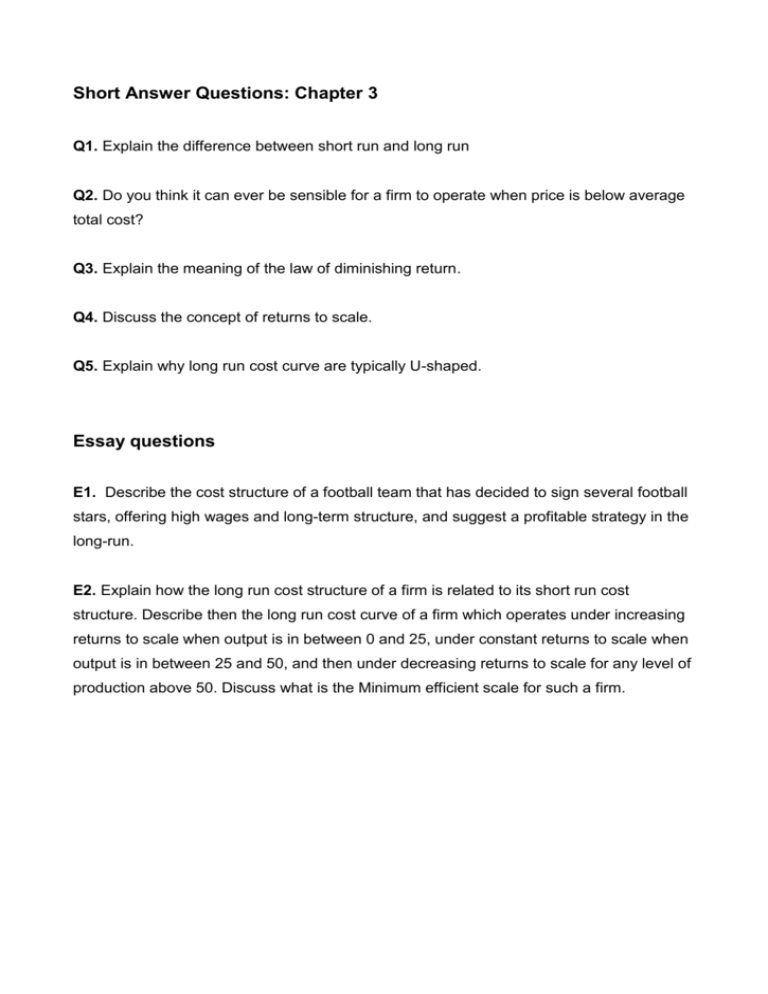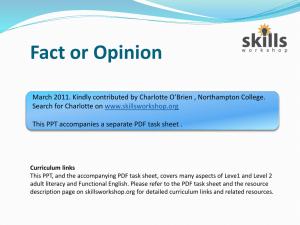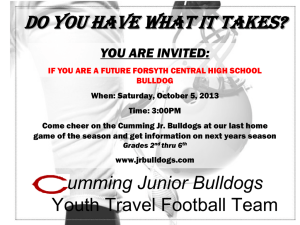Short Answer Questions: Chapter 3 Q1. Explain the difference
advertisement

Short Answer Questions: Chapter 3 Q1. Explain the difference between short run and long run Q2. Do you think it can ever be sensible for a firm to operate when price is below average total cost? Q3. Explain the meaning of the law of diminishing return. Q4. Discuss the concept of returns to scale. Q5. Explain why long run cost curve are typically U-shaped. Essay questions E1. Describe the cost structure of a football team that has decided to sign several football stars, offering high wages and long-term structure, and suggest a profitable strategy in the long-run. E2. Explain how the long run cost structure of a firm is related to its short run cost structure. Describe then the long run cost curve of a firm which operates under increasing returns to scale when output is in between 0 and 25, under constant returns to scale when output is in between 25 and 50, and then under decreasing returns to scale for any level of production above 50. Discuss what is the Minimum efficient scale for such a firm. ANSWERS: Short Answer Questions Q1. Explain the difference between short run and long run A: The short run is a period of time where one factor of production is fixed. We typically assume that capital is fixed and labour is variable, although this is not always the case. An example of where this is not the case is footballers for football teams or any other case in which workers sign long-term contracts. The long run instead is a period of time when all factors of production are variable and hence can be changed. Q2. Do you think it can ever be sensible for a firm to operate when price is below average total cost? A. Yes, a firm can operate when price is below average total cost as long as price is above average variable cost. In such a case, the firm, although making losses in the short run, can contribute to cover its fixed costs. If instead price is below average variable cost, the firm will close down. Q3. Explain the meaning of the law of diminishing return. A. The law of diminishing returns states that as more of a variable factor of production is added to a fixed factor of production then at some point the returns to the variable factor will diminish. One typically assumes that labour is the variable factor and capital is the fixed factor. Given the available amount of capital, the fixed factor, when we begin adding workers to the production process, these workers can exploit an under-utilized resource. So, the marginal product – the contribution to production of an extra worker - rises. When we begin to over-resource the production process with too much labour, there is no more capital to utilize. As a result, the marginal product begins to fall. At this point, the law of diminishing returns occurs. Q4. Discuss the concept of returns to scale. A. Returns to scale measure the change in output for a given change in the inputs and are therefore strictly related to the concept of long-run productivity. Returns to scale are increasing when output grows at a faster rate than inputs: for example, if doubling both capital and labour, output more than doubles. Decreasing returns exist when inputs grow at a faster rate than outputs: in the previous example, by doubling both capital and labour, output increases but less than doubles. Returns to scale are constant when inputs and outputs grow at the same rate: doubling capital and labour doubles output. Q5. Explain why long run cost curve are typically U-shaped. A. Long run cost curves are U-shaped because of the existence of economies and diseconomies of scale. Economies of scale are the cost advantages that a firm, or a business in general, obtains by expanding production. In other words, they are represented by the reduction in unit costs in the long run as the size of the firm – the scale – increases. Diseconomies of scale are the opposite: long-run average costs will eventually begin to rise when the size of the firm becomes excessively large. The most obvious reason is that as companies increase in size they become more difficult to control and co-ordinate. In presence of economies of scale before a threshold level of production, and diseconomies of scale once production is beyond this level, one has U-shaped long run cost curves. Essay questions E1. Describe the cost structure of a football team that has decided to sign several football stars, offering high wages and long-term structure, and suggest a profitable strategy in the long-run. Answer guidelines. You need to highlight that football players with long-term contract represent a fixed cost for the football team. Hence, fixed costs are very high compared to variable costs and when you draw the cost curves you will have that the the short-run average fixed cost curve and the short-run average total cost curve will be very similar for low levels of output. The problem of this football team is a problem of fixed cost. Hence, the strategy should be increasing output by increasing the number of matches the football team will play. E2. Explain how the long run cost structure of a firm is related to its short run cost structure. Describe then the long run cost curve of a firm which operates under increasing returns to scale when output is in between 0 and 25, under constant returns to scale when output is in between 25 and 50, and then under decreasing returns to scale for any level of production above 50. Discuss what is the Minimum efficient scale for such a firm. Answer guidelines. You should first draw the long run average cost curve as a collection of short run average cost curves in the typical U-shaped case. In the example of the question, between o and 25 the long run average cost curve will be decreasing with the level of output. Between 25 and 50, the LATC will be flat, and then increasing again for output above 50. In such a case, we have a continuum of levels of production that satisky the EMS, and not a single level.






